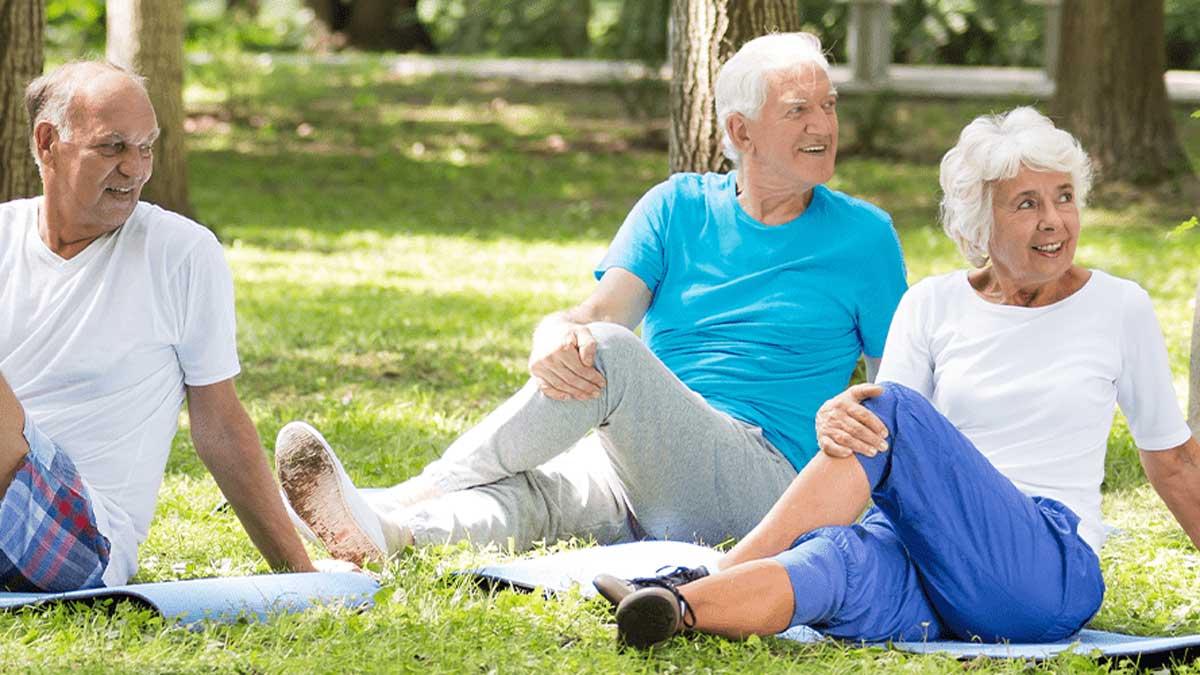Please note: Nothing in this article should be construed as medical advice. Please consult your licensed medical provider before beginning any senior fitness exercise program or new diet plan.
If you had access to something that could improve your life in just about every way, including reducing your chances of dementia, would you take it? If it could guarantee that you would not only look and feel better, but also potentially lengthen your life and the quality of your life, would you use it?
The Free, Powerful Tool That Boosts Brain and Body Health
Every single one of us has access to that benefit right now. It’s exercise.

“Exercise is the closest thing we’ve found to a magic pill for combating the effects of aging,” says Dr. Linda Fried, dean of Columbia University’s Mailman School of Public Health, in an interview with Columbia Magazine.
Exercise appears to have significant benefits to help ward off dementia. According to the Alzheimer’s Association,
Studies on exercise in middle-aged and older adults show a link to better thinking and memory. They also report lower rates of dementia.
And:
Research shows that people who exercise regularly may be up to 20% less likely to develop symptoms of dementia.
Exercise really can be a wonder drug. It’s easy to start, easy to enjoy, and best of all, it’s free.
Okay, it costs time and effort. But still, regular movement, along with healthy eating, helps fight aging better than any other non-medical treatment. Any exercise helps, at any age. Whether you jog, do chair yoga with a walker or practice wheelchair aerobics, you begin to enjoy the benefits immediately.
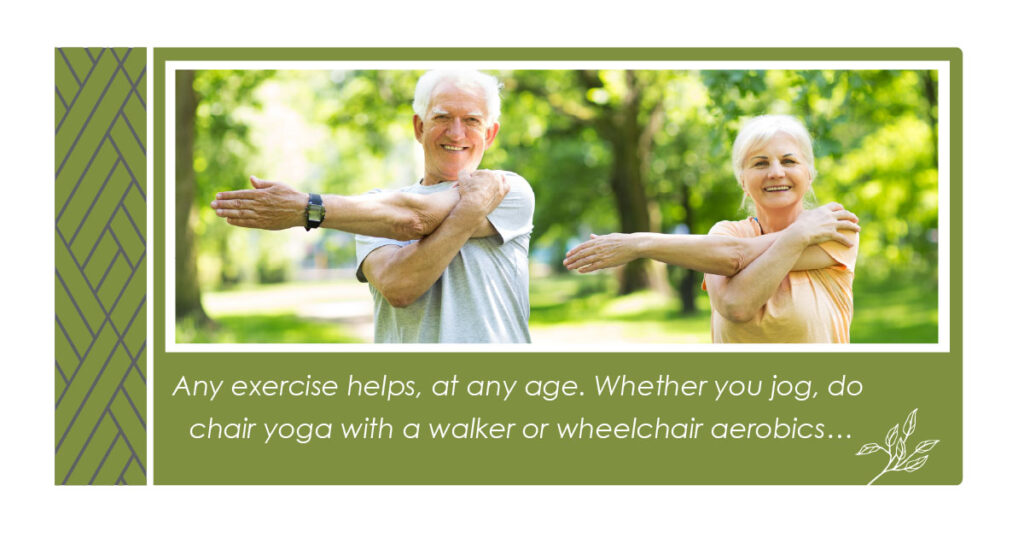
Getting started can feel overwhelming. If you feel this way, you’re in good company. With so much emphasis on extreme workouts, exercises for older adults don’t get enough attention.
Restarting Your Fitness Routine After a Break
I’m 71 and have prided myself on good lifelong exercise habits. But lately I’ve been feeling sluggish.
Surgeries and post-operative physical therapy sidelined a good bit of my exercise routine for the last five years. I couldn’t walk, run or work out normally. Boy, can I feel it, too!
A part of me wants to hurl myself at the machines at the gym. But too many older folks try to pick up where they left off decades ago. Not only is that foolhardy, it’s dangerous.
A wiser part of me knows that small steps make for a better comeback. It’s also the right way for anyone to start an exercise program: step by small, gentle step.
But which steps, and how much?
As with all things, it depends on you, your expectations and what you want your life to be like as you age. Whether it’s overall strength or improving your balance, it’s all important. It also depends on whether you’re willing to invest a little time to get all the benefits.
How to Build a Senior Fitness Routine That Sticks
You may be familiar with Internet phenomenon Joan MacDonald. By 78 years old, she achieved remarkable results after doctors diagnosed her with multiple serious illnesses at 70. She transformed herself into a fitness phenom and has the body to prove it. Lots of folks our age want what she has: terrific health, a great outlook and better quality of life.
Joan worked to transform herself several hours a day, six days a week for years. She took supplements and ate special food to work with her fitness pro daughter in Mexico. Her entire life now revolves around exercising.
Great inspiration and achievement, but is that realistic for the rest of us?
If you want to be healthier and live your best life (and who doesn’t?), there’s an easier way. Most of us need gentle exercises for seniors to begin.
Here’s what the National Institutes of Health (NIH) recommends. In this series of articles, the NIH explains what you can work up to over time.
According to the Physical Activity Guidelines for Americans, you should:
- Aim for at least 150 minutes (2½ hours) of moderate exercise each week. This can include activities like brisk walking or fast dancing.
- You should also do muscle-strengthening activities, like lifting weights or doing sit-ups, at least two days a week.
- For best results, try to combine multiple components of exercises. For example: try balance training as well as aerobic and muscle-strengthening activities.
- If you prefer vigorous-intensity aerobic activity (like running or cycling), aim for at least 75 minutes a week.
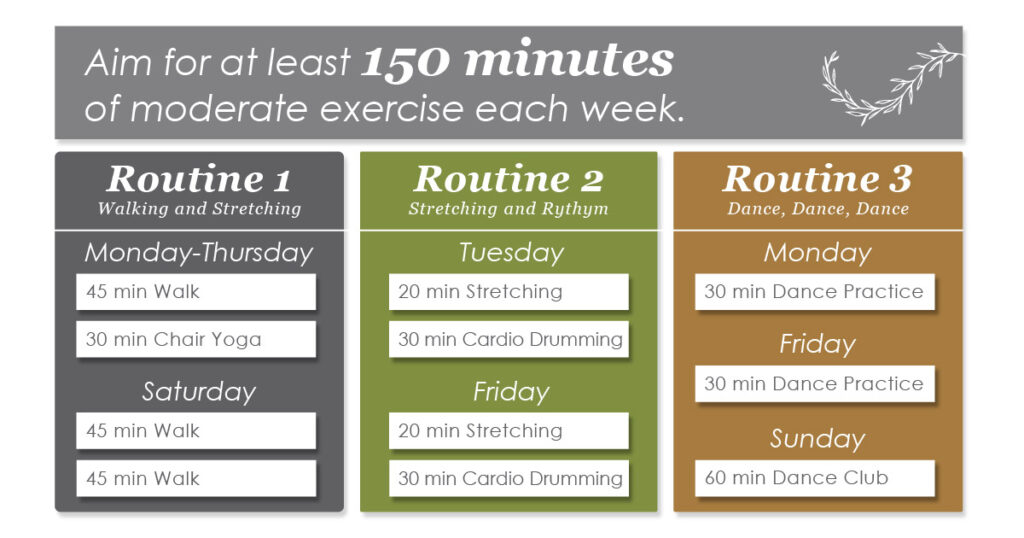
Being active at least three days a week is best, but doing anything is better than doing nothing at all.
If you live in a Hawthorn community, consider engaging with a licensed physical therapist. These medical professionals work independently from the community. They are third-party providers and offer their services on-site for your convenience. They can help you build an exercise routine that is safe and focused on your personal health goals.
But all this can sound like a lot if you’ve never exercised regularly.
Let’s put this into perspective. You and I have 168 hours every week. NIH suggests that we take only two and a half for our exercise program. That’s only a fraction of all the time we have.
Isn’t your overall health, including helping prevent dementia, worth a small fraction of your time?
I think so. You will, too, once you enjoy the benefits of gentle exercise for seniors to get you started.
We still need to work up to that point. “Until we have our healthy habits set, any hope of moving for two and a half hours a week is hard to reach.” That journey begins with one step. Ideally, it’s an easy one to repeat.
Here’s what I did.
Small Habits, Big Results: The Power of Consistency
Right before bed I used to toss a warm top on my favorite chair. Upon waking up, instead of grabbing my dumbbells (also close by), I grabbed the top. Then I’d pad to my office and start working. Three hours later I’d still be in my jammies, tired, slumped over, and in no mood to exercise, because now my back hurt.
In his terrific book Atomic Habits, James Clear writes that it’s not about the goal, such as to lose 10 pounds. We need a way of life that helps us build whole-person wellness doing things we genuinely enjoy doing. That’s built on choices, which become habits. Habits become systems that support quality of life.
That way, when we successfully drop the 10 pounds, they stay off. Habits make it easier to stay active.
Start With One Simple Habit
My first habit to break: choosing my computer instead of a few exercises each morning.
I put my laptop away at night. Now, to warm up for the day, I do a few sets with light dumbbells. Those few moments of happy movement make all the difference. It also makes me want to do more.
I’m adding the “more” in similarly small increments, until they become habits. Each small step – each new habit – is part of a system that is helping me refocus on exercise during my favorite time of day.
The more I exercise, the better I feel, the more I want to move.
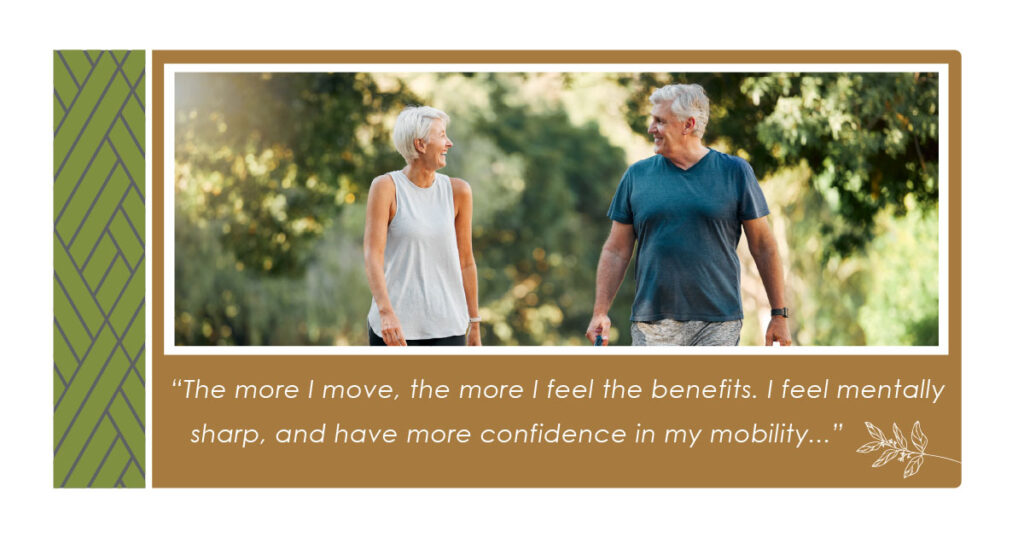
Easy Ways to Begin Exercising at Any Age
At Hawthorn, all communities feature circular walking paths around the building. Walk a mile or just walk a while. Walk alone or invite a friend. Either way, research says that even walking does the body lots of good, especially for those interested in senior fitness.
According to an article by Harvard Health Publishing,
Older people who are physically active and who exercise regularly are more likely to walk without assistance and do other activities of daily living on their own.
Set a habit of regular walks around the community. Invite friends for even greater benefit. When movement becomes fun, you’ll want to do more of it.
Hawthorn communities feature a broad variety of classes and gym equipment specifically designed for every age and ability. If you have mobility or disability issues, you can get help with the machines. If weights or machines aren’t for you, you can explore a variety of classes.
Wellness classes offer the chance to meet new friends. Nothing motivates so much as having fun. When friends join us for exercise, we benefit even more.
Weather doesn’t need to stop you, either! Explore indoor classes during rain or snow, and walk outdoors when the weather favors both you and the flowers.
The National Institutes of Health suggests:
- Begin your exercise program slowly with low-intensity exercises.
- Warm up before exercising and cool down afterward.
- Pay attention to your surroundings when exercising outdoors.
- Drink water before, during and after your workout session, even if you don’t feel thirsty.
- Wear appropriate fitness clothes and shoes for your activity.
- If you have specific health conditions, discuss your exercise and physical activity plan with your health care provider.
Just start. If you stay open and curious, something will eventually appeal to you. When it does, you’ll make time for it.
As soon as it becomes a habit, you have the start of a system. Systems support healthy aging by becoming part of who you are, not when they’re just a task on your to-do list.
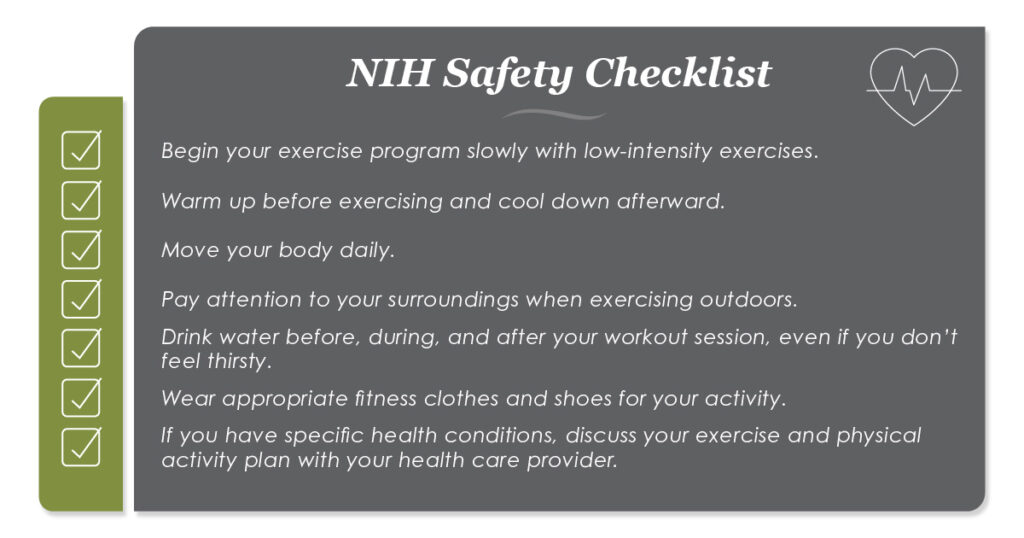
How Hawthorn Communities Make Fitness Easy and Enjoyable
Choosing to live in an independent senior living community comes with many benefits. All Hawthorn communities include a convenient gym, regular fitness classes and beautiful places to walk – along with neighbors and friends who appreciate fitness like you do, and Activity Coordinators dedicated to creating activities that delight and challenge your fitness in all areas. These perks are all designed to support your journey at no extra cost.
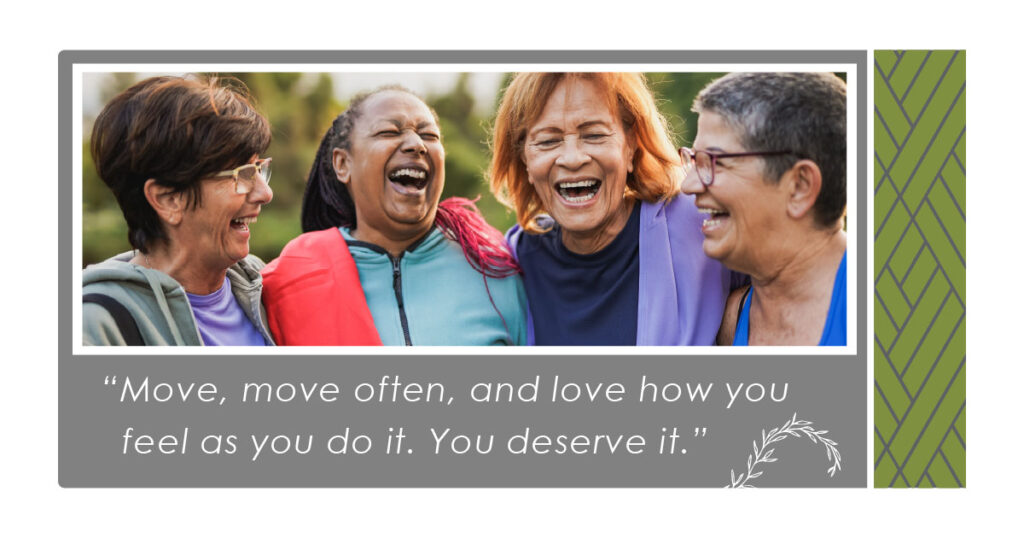
Let’s reduce the chances of heart disease, cognitive decline and many of the illnesses that can plague us as we age. The best way to do that is to move, move often and love how you feel as you do it. You deserve it.
DID YOU ENJOY WHAT YOU JUST READ?
Join our exclusive community and subscribe now for the latest news delivered straight to your inbox. By clicking Subscribe, you confirm that you agree to our terms and conditions.
Related Articles
STORIES, INSIGHTS & RESOURCES
As you and your loved ones navigate the exciting opportunities retirement presents, thoughtful planning is key. Stay informed with empowering articles for seniors covering health, lifestyle, finance and more.
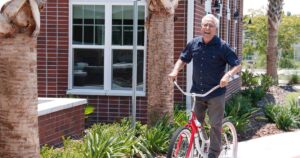
What Is Short-Term Senior Living?
When it comes to senior living options, there’s no one-size-fits-all solution. Adults today are increasingly seeking flexibility and variety in their retirement years, and one…

Lively Friendships at Every Age: How Making Friends Leads to Healthy Aging
by Julia Hubbel Feeling lonely? You’re not alone. In fact, those of us who feel lonely are in excellent company, yet remarkably, we’re not finding…

Embrace Change: Saying Yes in Your Retirement Years
Retirement. What images does it conjure up? A time to break free from the hectic pace of life? Adventure? Exploration? As enticing as that may…

The Potent Power of Positive Attitude on Whole-Person Wellness for Seniors
by Julia Hubbel Most of us want our later years to be easier, right? Less worry, less stress, more happiness and greater joy. After a…
Chronicles Of The Heart
RESIDENTS SAY INDEPENDENCE IS A TOP PRIORITY
Below, residents explain how much they appreciate the freedom they experience at our independent living community. It’s empowering to continue to make your own decisions, and you’re free to create your day around your personal interests.

